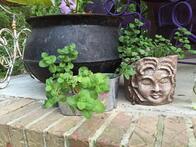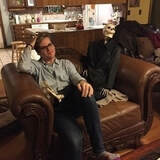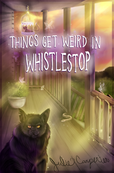Sacred Chickens
Menu
SACRED CHICKENS
 Women and the Power of the Earth by Jarad Johnson Spoiler Alert! This article is meant to discuss the intersection of witchcraft and horticulture and goes beyond merely reviewing the book. There will be spoilers. A few years ago, I reviewed The Physick Book of Deliverance Dane, which you can read here. I ended up reading it for class this semester, and my gardening senses started tingling when I read about all the plants in the book. I decided to write a paper about the herbs that the witches/healers used in the book, and horticulture's relation historically to witchcraft. Witches and witchcraft permeate our culture. Every Halloween, without fail, congeries of witch hats flood the streets. There seems to be a cultural fascination with them, especially in recent years. However, witchcraft as a scholarly expedition is not new. Countless articles, journals and books have been written about them. The topics of incubi and succubi, demons, turning into animals, the devil and midnight joy rides on various cleaning apparatus are nearly to the point of being overdone. Well, maybe there’s room for more stories about traveling on appliances as technology advances. Who’s up for some stories about witches riding roombas? Basically, everything that can be said about the Salem Witch Trials probably has been, but there’s another aspect of witchery I’d like to explore, a perspective that’s delineated quite well in the novel, The Physick Book of Deliverance Dane. When I think of witches, plants are inevitably tied to that image. Some plants are associated with witches: Saint John’s Wort, Witch Hazel, and Belladonna (also a great Stevie Nicks song!) among them. But, for all the research and scholarly essays written about witches, the plants historically associated with them have only been studied more recently. Most of the history of witchcraft is about flying on broomsticks and dalliances with the devil; however, this novel reimagines the ties between witches and horticulture. That’s one of the reasons why I love it! Witches! And Gardens! While the book is obviously fiction, it rethinks some of our negative tropes of witches, and it does so with a firm connection to gardening. Before the novel even begins, we see a drawing of a mandrake root on one of the very first pages, signaling to the reader not only an important plot point, but also that plants will be involved. The novel is about a woman named Connie who inherits a house and discovers a magic book belonging to Deliverance Dane. I highly recommend it. But I don’t want to focus so much on the plot or literary concerns as the book’s perspective on witchcraft. Rather than present us with the old patriarchal trope of women in service to Satan, here we see women who draw power and strength from the earth, not some misogynistic deity. This is not a story about the traditional witch, as it is lacking the element of the demonized woman; those accused of witchcraft were often folk healers or midwives, and the entire concept of a witch is a woman who has secret knowledge with which to threaten men. This definition of a witch, in fact, seems to more suit the definition of a healer, but with magic. The novel’s protagonist finds a book belonging to Deliverance Dane, a woman who was put to death in Salem as a witch. It becomes clear that Dane was a gardener and a healer. A healer is usually, “one who combines a knowledge of herbs with careful use of white magic,” (Jones, p.1). Deliverance is very different from the stereotypical witch because she’s using her gifts for good instead of evil, reversing the usual patriarchal paradigm. She treats calves, and ailments, and delivers babies. Sarah Bartlett comments early on, “Of all the cunning folk in the county,” that, “Livvy Dane knows her way wi’ physick above all,” (Howe, p. 106). Her magic is referred to as physick, and at several points throughout the text she is shown working with herbs to make her remedies. They are in fact vital to her cures. It was believed for a very long time that witches could not only harm people, but also, “to cure diseases in which physicians had been unsuccessful,” (Deetjen, p. 11). Deliverance, clearly, was not thought to be an evil person, but rather a vital part of the community, and arguably one of the most devout people in it. Witches and the Christian faith are not usually associated or even depicted as anything other than complete opposites, to put it mildly. It’s gotten kind of heated over the centuries. (In fact, very heated right up to the point of burning women accused of witchcraft!) But Deliverance’s book from whence she derives all of her physick also heavily features the father, the son and the holy ghost as well as healing and herbs. This was true of many “white witches” and herb women who were the counter to the wielders of black magic. Many of them believed that their curing abilities were, “a special gift from god,” (Jones, p.9). Instead of the devil, Deliverance’s power appears to strike a balance between divine power and power derived from the earth, and many times they appear to be one and the same. More than anything else, these women understood the gifts of nature and learned to make use of them for the greater good. The novel is set in the nineteen nineties and along with the book the protagonist, Connie, inherits a garden from her grandmother. From this we get the most expansive description of the plants that grow within the gardens of the women in this novel. It is the setting for much of the books drama, fittingly, and is a constant presence in the background. When Connie first comes upon her grandmother’s garden, she sees herbs typical of a kitchen garden: parsley, chives, rosemary and thyme. She then comes upon other plants that she has seen in horticulture books: monkshood, henbane, foxglove, and, “A thick, ropey belladonna that clung to the left corner of the house,” (Howe, p. 39). She also encounters elder, alder and hawthorn trees, all of them medicinal. However, everything is overgrown, the belladonna is tearing apart the wall and the chives haven’t been harvested in a long time. The garden without a witch to tend it is out of control and of no use to anyone. It doesn’t take long for Connie and her friend to begin harvesting probably near-wild vegetables from the garden for supper. There are plants in there that we would commonly call poisonous, but if used correctly, they also have medicinal values. This is obviously a garden used for magic, passed down through over time. There is credence to the idea that the garden is unique to the gardener, so what does that description say about Connie’s grandmother? What will our gardens say about us? Perhaps somewhat obviously, given the nature of the book, the typical witch often has, “some knowledge of herbs,” so she would have known how to use the typical, “poisonous,” plants for medicinal purposes (Deetjen, p. 11). Interestingly, in what I would imagine is in the true spirit of New England, there are no decorative plants, no roses or peonies, daffodils or hydrangeas; everything in that garden has a purpose for her craft, and there’s no frivolity in sight. Aesthetics are not the goal here, the plants are not there for the beauty of their flowers, they are there to serve a purpose beyond the decorative. Everything and every plant is able to used in one way or the other, whether that be a witchy or medicinal herb or a vegetable. Deliverance Dane’s recipes are spells and some of them are even of help in the garden. There’s a memorable scene when Connie makes a ripe tomato appear - enough to make any gardener jealous. The garden is the key to Connie’s self-actualization. Connie (bless her heart), at the beginning of the novel, is in complete denial of her witchy side, as well struggling with a whole host of other issues, attempting to fit with the (pompous) academia at her college, to avoid becoming like her mother. And yet, when she makes that tomato appear, the beginnings of a realization start to happen in her mind. So, the catalyst of her acceptance of her powers hinged on a tomato and a dandelion. The garden represents the power of the earth, and Connie’s power as a woman as well. You could say that when Connie formed a connection with the earth, only then was she able to realize, and believe in, her own strength. In fact, now that I think about it, every sweet acidic garden tomato has a little magic in it, whether you have to wait for it to grow or not. There are many more references to female characters and nature. One character was a farmer and kept a close eye on the weather keeping a daily catalogue of it in her diary. Even before discovering the garden Connie, of course, had her houseplants, which came with her when she went to clean out her grandmother’s house (this is very relatable), so they must bring her some element of comfort and they are clearly important to her. In fact, all the women in the book seem to form this connection to plants almost subconsciously, and without thinking. They have a connection to the earth and soil that, especially in Deliverance’s time, was not common. The Puritans used the earth to grow their vegetables and the like, of course, but they were afraid of nature and distanced themselves from it. There were always devils lurking in the forests, and ghouls in the shadows. And of course, every, “known sickness of mind and body,” must’ve been the work of a witch, a woman with too much knowledge (Deetjen, p.5). Women having their own minds were easy targets for frightened men. It seems contradictory, in some ways. If god created the natural world, then surely, it must be divine and sacred? Surely nature is to be respected, not feared and hated. Sadly Puritan logic did not work that way, and not all of modern Christianity had changed its viewpoint on either nature or women. For the Puritans, witches had to be burned and disposed of, as they were, “More or less deranged women.”(Deetjen, p. 11) No one wanted to deal with these women who were not completely subservient to men (thus threatening their patriarchal chokehold on society). This disruption of the power structure must have been in league with the devil. Regardless, Deliverance and her descendants, all the way up to Connie, eventually saw the divinity in the plants and herbs, and by extension the whole of the natural world, that they constantly worked with. This seems to be true of many herb women over the centuries. As was also true of many herb women, Deliverance’s good deeds and healing powers did not win her any favors with the townspeople. Unfortunately, we can’t talk about witches without talking about Witch Trials. In the United States, the Salem trials stand out as a violent and shameful moment in American history. Reputation was everything for the puritans, standing in the community was vital, and once they had cause to ostracize a woman, more so than normal, they jumped at the opportunity. Although Deliverance Dane was a real person, her history is somewhat scanty. Howe has reimagined her as a fictional person, however, her fate was not unlike that of many women put to death for witchcraft. Healers were often suspected of witchcraft. “Among all these practitioners, regardless of nomenclature, will be found specialists whose reputation depend upon a bent for special types of medical problems,” (Jones, p.1). In the novel, Deliverance’s standing in the Puritan community was always tenuous at best. She was known for her abilities to heal and fix people’s ailments, but with that comes a level of suspicion typical of the Puritans. (Remember the puritans were known to whip Quakers and Anabaptists out of town). She would always be an outsider in the community, in large part because of the knowledge she held about plants and herbs, and how she used them. They only tolerated her because she was useful to them, and once that situation became untenable, and she was perceived as a threat, even paltry tolerance was no longer viable. Those who do not conform to the expectations of society threaten the entire system, even if they have committed no crimes. After a period of imprisonment, Deliverance is hanged. The book dwells on the fact that she is hanged for helping people, by using her herbs and plants, and her connection to the earth. And while many people would not be as healthy, or even alive, without her physick, that is quickly forgotten in the face of the allegation of, “witch.” We see how important the plants are in this book, obviously; they are vital to the story. Plants and herbs are on nearly every page, and they are fascinating. But we also see what the cost of knowledge can be, especially for women. Works Cited DEETJEN, CHRISTIAN. “WITCHCRAFT AND MEDICINE.” Bulletin of the Institute of the History of Medicine, vol. 2, no. 3, 1934, pp. 164–175. JSTOR, www.jstor.org/stable/44437785. Howe, Katherine. The Physick Book of Deliverance Dane. Hachette Books, 2016. JONES, LOUIS C. “PRACTITIONERS OF FOLK MEDICINE.” Bulletin of the History of Medicine, vol. 23, no. 5, 1949, pp. 480–493. JSTOR, www.jstor.org/stable/44442274.  Bio: Jarad is the co-administrator and writer for Sacred Chickens, attends college at MTSU, loves tea and coffee, and tries to spend every spare second reading. He recently developed an interest (some might say obsession) with gardening. Jarad is an English major with a concentration in literature. Bless his heart! Let's all light a candle for him and send him happy thoughts!
2 Comments
Not Myname
3/26/2024 01:29:47 am
Why read the book if you are going to tell us the ending, not a great review.
Reply
Leave a Reply. |

Click Photo above to buy ebook or paperback from Amazon.
Here's the link to Barnes and Noble Or order through your favorite independent bookstore! Categories
All
|
 RSS Feed
RSS Feed